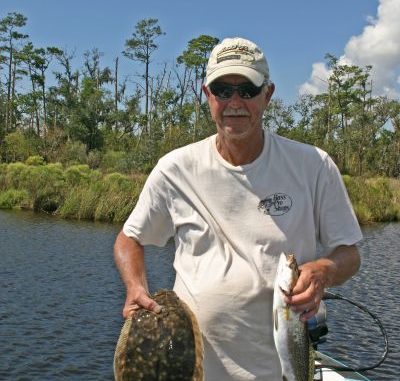
Lake Pontchartrain specks move up bayous, hit Fluke-like baits.
When I was young, I could not wait until teal season each September. Hunting was not the plan, but fishing around Bayou Lacombe was.
Each September brought a change in the weather and the trout along the shoreline and bayous around Lacombe and Slidell. Not much has changed, except there is less grass in the lake. As cool fronts pass through and the hunters boom away at the teal, the trout simply stack up in Bayou Lacombe and Liberty.
A few good trips this week brought back memories of my youth. A limit on trout on Tuesday (Sept. 25), and about 35 trout yesterday with my fishing buddy Bill Toler proved the fishing to be good as past years.
Trout are scattered up and down each bayou, from the lake to several bends upriver from the Lake Pontchartrain. With a few lightweight jigheads, some jerk shad (flukes, Gulp!, Powerbait) and Berkley 100% Fluorocarbon, trout are there for the taking.
Our morning started out in Lacombe about a bend north of the Lakeshore launch. The trout were up tight on the bank and biting just about every cast.
After landing a few nice fish, the jack crevalles ripped up the water and put the trout down the road.
After landing a few flounder by dragging ¼-ounce heads in the middle of the bayou, the bite slowed and we moved over to Bayou Liberty.
The trout seemed to be scattered. A bite off the bank, then a bite in the middle of the canal seemed to signal the pattern was going to be hard to lock down.
Since the tide was mostly wind-driven and not very strong, the ledge bite was not pretty weak. After noon, the tide began pouring in and pushed the fish tighter to the bank.
Overall, we ended the day with about 35 trout, several white trout, and five nice flounders.
For success in the Lacombe area, bring ⅛- to ¼-ounce jigheads and several packs of jerk shads. Anything shad-colored bait — white, pearl, albino, smelt — should work.
Cast the jigs close to the bank, and slowly lift or hop the bait off the bottom and back to the boat. Most strikes occur on the fall, so let the bait fall until it rests on the bottom.
The strike is light, so it’s it’s hard to detect. Usually, when the rod is lifted to work the bait again, a slight pressure is all that is felt.
Six-, 8- or 10-pound Berkley 100% Fluorocarbon is recommended. Just be sure to retie often. Medium-light or medium-action rods are my favorite for the technique.
Find more reports — and post your own — in the Inshore Fishing Forum. Not a member yet? It’s free, so click here to register and get started today!
